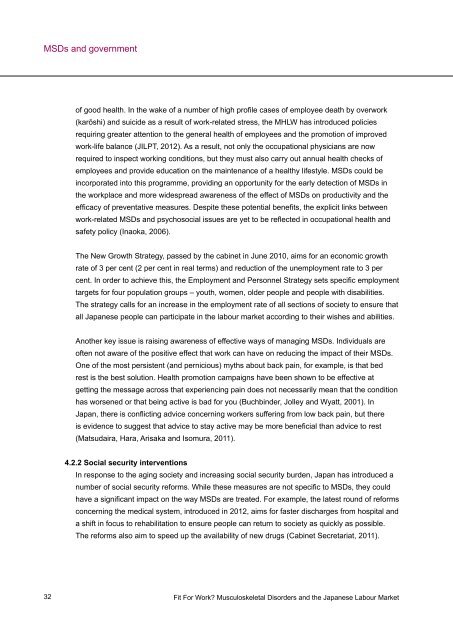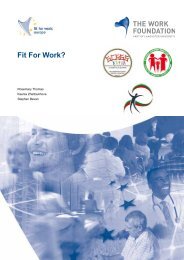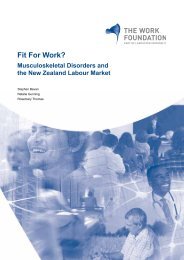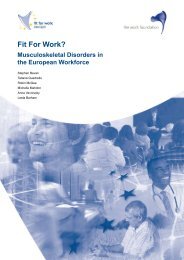English version - Fit for Work Europe
English version - Fit for Work Europe
English version - Fit for Work Europe
You also want an ePaper? Increase the reach of your titles
YUMPU automatically turns print PDFs into web optimized ePapers that Google loves.
MSDs and government<br />
32<br />
of good health. In the wake of a number of high profile cases of employee death by overwork<br />
(karōshi) and suicide as a result of work-related stress, the MHLW has introduced policies<br />
requiring greater attention to the general health of employees and the promotion of improved<br />
work-life balance (JILPT, 2012). As a result, not only the occupational physicians are now<br />
required to inspect working conditions, but they must also carry out annual health checks of<br />
employees and provide education on the maintenance of a healthy lifestyle. MSDs could be<br />
incorporated into this programme, providing an opportunity <strong>for</strong> the early detection of MSDs in<br />
the workplace and more widespread awareness of the effect of MSDs on productivity and the<br />
efficacy of preventative measures. Despite these potential benefits, the explicit links between<br />
work-related MSDs and psychosocial issues are yet to be reflected in occupational health and<br />
safety policy (Inaoka, 2006).<br />
The New Growth Strategy, passed by the cabinet in June 2010, aims <strong>for</strong> an economic growth<br />
rate of 3 per cent (2 per cent in real terms) and reduction of the unemployment rate to 3 per<br />
cent. In order to achieve this, the Employment and Personnel Strategy sets specific employment<br />
targets <strong>for</strong> four population groups – youth, women, older people and people with disabilities.<br />
The strategy calls <strong>for</strong> an increase in the employment rate of all sections of society to ensure that<br />
all Japanese people can participate in the labour market according to their wishes and abilities.<br />
Another key issue is raising awareness of effective ways of managing MSDs. Individuals are<br />
often not aware of the positive effect that work can have on reducing the impact of their MSDs.<br />
One of the most persistent (and pernicious) myths about back pain, <strong>for</strong> example, is that bed<br />
rest is the best solution. Health promotion campaigns have been shown to be effective at<br />
getting the message across that experiencing pain does not necessarily mean that the condition<br />
has worsened or that being active is bad <strong>for</strong> you (Buchbinder, Jolley and Wyatt, 2001). In<br />
Japan, there is conflicting advice concerning workers suffering from low back pain, but there<br />
is evidence to suggest that advice to stay active may be more beneficial than advice to rest<br />
(Matsudaira, Hara, Arisaka and Isomura, 2011).<br />
4.2.2 Social security interventions<br />
In response to the aging society and increasing social security burden, Japan has introduced a<br />
number of social security re<strong>for</strong>ms. While these measures are not specific to MSDs, they could<br />
have a significant impact on the way MSDs are treated. For example, the latest round of re<strong>for</strong>ms<br />
concerning the medical system, introduced in 2012, aims <strong>for</strong> faster discharges from hospital and<br />
a shift in focus to rehabilitation to ensure people can return to society as quickly as possible.<br />
The re<strong>for</strong>ms also aim to speed up the availability of new drugs (Cabinet Secretariat, 2011).<br />
<strong>Fit</strong> For <strong>Work</strong>? Musculoskeletal Disorders and the Japanese Labour Market







